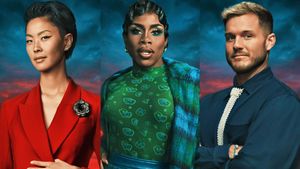The number of U.S. adults who identify as LGBTQ+ has increased to 7.1 percent, according to a new poll released by Gallup.
That's 1.5 percentage points higher than last year and double the percentage Gallup reported in 2012.
The pollster asked Americans if they identified as straight or heterosexual, lesbian, gay, bisexual, or transgender as part of demographic information it collects on all of its U.S. telephone surveys, Gallup said in a news release Thursday. The respondent also had the opportunity to say another sexuality or gender identity than the categories provided by Gallup.
More than 12,000 adults participated in the surveys conducted last year.
Besides the 7.1 percent identifying as LGBTQ+, 86 percent said they identified as straight while 6.6 percent didn't offer an answer.
Gallup found that one in five Gen Z adults identified as LGBTQ+ with older generations identifying less so. While the percentages of baby boomers and Gen X adults who identify as LGBTQ+ have remained consistent, millennials have continued to identify more as LGBTQ+ -- increasing from 5.8 percent in 2012 to 7.8 percent in 2017 to 10.5 percent in 2021.
The global analytics firm found bisexuality was the most common identity category. Almost 60 percent of queer respondents identified as bisexual -- so about 4 percent of the U.S. population. Additionally, 21 percent of queer respondents identified as gay, 14 percent lesbian, 10 percent trans, and 4 percent as something else. Each of these categories represented less than 2 percent of the U.S. population.
Women were also found to identify more than men as bisexual.
"I think the main thing is getting an idea of how large the population is for all these subgroups. It's something that we don't have a really good handle on," Gallup senior editor Jeffrey Jones told The Advocate. "But through our data, you get a sense of that, and just how society is changing and how individuals ... think about their sexual orientation or their gender identity."
In its results, Gallup said that it expected LGBTQ+ Americans to make up more than 10 percent of the U.S. population in the near future, although the group didn't give a specific timeline.
"It'd be hard to see anything different happening just because the generational patterns are pretty well established," Jones said, referring to the upward trend in those who identify as LGBTQ+. "If Gen Z ends up being reflective of the generations behind them and we could see where one in five Americans identify as LGBT."
Jones said that in previous decades people wouldn't have the knowledge to question their identities like they can and do today. People went with what they were assigned at birth or what was expected of them. Now that's not the case.
"That's not something that people would have thought about necessarily decades ago, but now it's kind of like a legitimate question that people would have," he said. "Fifty or 60 years ago ... a majority of people thought it was wrong to be gay or lesbian, [but] now, Americans have a very opposite view or think it's perfectly fine."
Coupled with a reduction in discrimination against LGBTQ+, people have been allowed to identify and come out in recent generations. Jones said that anti-LGBTQ+ discrimination is something people don't tolerate as they did, resulting in more people identifying as LGBTQ+: "It's something that people want to kind of, you know, speak out against, and fight against."





































































Charlie Kirk DID say stoning gay people was the 'perfect law' — and these other heinous quotes